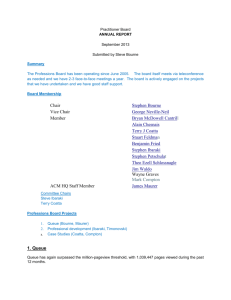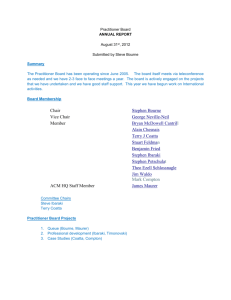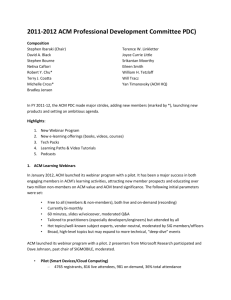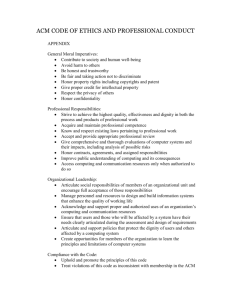Professions Board
advertisement
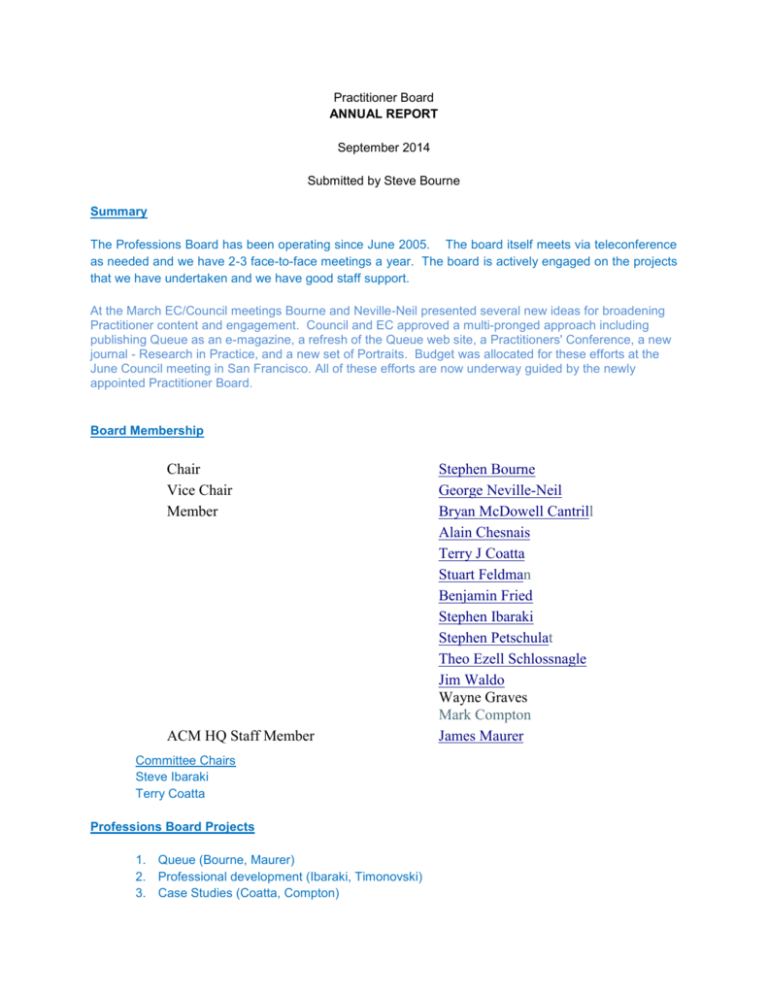
Practitioner Board ANNUAL REPORT September 2014 Submitted by Steve Bourne Summary The Professions Board has been operating since June 2005. The board itself meets via teleconference as needed and we have 2-3 face-to-face meetings a year. The board is actively engaged on the projects that we have undertaken and we have good staff support. At the March EC/Council meetings Bourne and Neville-Neil presented several new ideas for broadening Practitioner content and engagement. Council and EC approved a multi-pronged approach including publishing Queue as an e-magazine, a refresh of the Queue web site, a Practitioners' Conference, a new journal - Research in Practice, and a new set of Portraits. Budget was allocated for these efforts at the June Council meeting in San Francisco. All of these efforts are now underway guided by the newly appointed Practitioner Board. Board Membership Chair Vice Chair Member ACM HQ Staff Member Committee Chairs Steve Ibaraki Terry Coatta Professions Board Projects 1. Queue (Bourne, Maurer) 2. Professional development (Ibaraki, Timonovski) 3. Case Studies (Coatta, Compton) Stephen Bourne George Neville-Neil Bryan McDowell Cantrill Alain Chesnais Terry J Coatta Stuart Feldman Benjamin Fried Stephen Ibaraki Stephen Petschulat Theo Ezell Schlossnagle Jim Waldo Wayne Graves Mark Compton James Maurer 1. Queue For the fourth consecutive year, Queue has surpassed the million-pageview threshold with 1,158,741 pages viewed during the past 12 months. By every measure, usage of the Queue website is up significantly. Comparing this year to last (September 2013 through August 2014): Number of readers is up by 5.5% (up 35% from 5 years ago) Number of visits up by 6.4% (up 31% from 5 years ago) Number of pages viewed up by 7.7% (up 20% from 5 years ago) --Queue has been getting more attention through “social media” sites Reddit continues to be the most significant referring site by volume, with Twitter as a close second. Traffic from Reddit is up 5.2% from last year Traffic from Twitter is up 34.5% Traffic from Slashdot is up 10.3% --These were the most-read articles and columns over the past 12 months. Pub date Views Author Oct-13 66,966 Jacob Loveless Apr-14 62,860 Erik Meijer Apr-14 Mar-14 44,555 25,143 Poul-Henning Kamp Christoph Paasch Apr-14 24,999 Wyatt Lloyd Jan-14 23,525 Anil Madhavapeddy May-10 20,182 Jeffrey Heer Oct-13 19,288 Jacob Loveless Jul-11 18,493 Poul-Henning Kamp Dec-13 Jul-14 Dec-13 Sep-12 16,574 16,397 16,015 13,955 Ilya Grigorik Peter Bailis Nick Feamster Kripa Krishnan Title Barbarians at the Gateways The Curse of the Excluded Middle Please Put OpenSSL Out of Its Misery Multipath TCP Don't Settle for Eventual Consistency Unikernels: Rise of the Virtual Library Operating System A Tour through the Visualization Zoo Online Algorithms in High-frequency Trading The Most Expensive One-byte Mistake Making the Web Faster with HTTP 2.0 The Network is Reliable The Road to SDN Weathering the Jun-14 13,404 Poul-Henning Kamp Mar-08 13,294 Ulrich Drepper Apr-12 Sep-11 May-14 Dec-13 13,114 10,849 10,750 10,411 Kari Pulli Yaron Minsky Thomas Wadlow Alex E. Bell Jul-14 10,195 Vinton G. Cerf Unexpected Quality Software Costs Money - Heartbleed Was Free The Cost of Virtualization Realtime Computer Vision with OpenCV OCaml for the Masses Who Must You Trust? The Software Inferno ACM and the Professional Programmer This past year, 20 Queue articles were each read more than 10,000 times, more than any other year. Several of these popular articles are from previous years, showing the lasting value of Queue content. 2. Professional Development Committee Professional Development Committee (PDC) FY 2014 (*New members joined in 2014) Stephen Ibaraki (Chair), Eve Andersson*, David A. Black, Stephen Bourne, Netiva Caftori, Robert Y. Chu, Terry J. Coatta, Michelle Cross, Don Gotterbarn, Dominic Holt*, Bradley Jensen, Terence W. Linkletter, Srikantan Moorthy, Dave O’Leary*, William H. Tetzlaff, Will Tracz, Yan Timanovsky (ACM HQ) FY 2015 Stephen Ibaraki (Chair), Eve Andersson*, David A. Black, Don Gotterbarn, Dominic Holt*, Bradley Jensen, Terence W. Linkletter, Srikantan Moorthy, Dave O’Leary*, Will Tracz, Yan Timanovsky (ACM HQ) Webinar Subcommittee (PDC-W): Will Tracz (acting chair PDC-W, acting vice-chair PDC and exec sub-committee), Stephen Ibaraki, Tan Moorthy, Yan Timanovsky (ACM HQ) Professionalism and Certification Subcommittee (PDC-PCC): The PCC is charged with scanning the computing professionalism, licensing, and certification landscape for important new developments so ACM is prepared to act if necessary. Three members are also in the ICCP where the ACM is a founding member. It consists of: Terry Linkletter (acting chair PDC-PCC, acting vice-chair PDC and exec sub-committee, ICCP ACM contributor), Don Gotterbarn (ICCP board ACM rep), Stephen Ibaraki, Bradley Jensen (ICCP board ACM rep), Srikantan Moorthy, Yan Timanovsky (ACM HQ) In FY 2014, the ACM PDC continued the successful webinar series with consistent monthly webcasts, tighter integration with SIGS and a more diverse set of topics and presenters. Monthly ACM Learning Center bulletins profiling ACM value, products and services reach over 160,000 professionals, Webinar bulletins reach over 400,000 professionals, and through ACM PDC member social media and media channels over 10 million potential audience reach. In April 2014, we had our first webcam “talking head” event with ACM Fellow Peter Neumann and in June 2014 we held a policy-oriented event on cybersecurity education. Three new members were added with a view to revitalizing the membership, including more practitioners, extending the reach of ACM Learning Center announcements through PDC member channels thus enhancing the value brand of the ACM products/services and working to retain and grow membership. The PDC ratified a new charter and operational guidelines set to commence in FY 2015 with a focus on specific measurable timely objectives, metrics targeting value delivery, services change management, agility, succession planning. Other activities are summarized below. Highlights: A. Webinar Program B. E-learning offerings (books, videos, courses) C. Tech Packs D. Podcasts E. Partnerships A. ACM Learning Webinars Since September 2013, there have been 13 Learning Webinars broadcast or scheduled. Our presenters and moderators included a Past ACM President, ACM fellows, members of the PDC, PB, and Queue editorial board, SIG officers and members, and practitioners from industry. Some examples: 1. IPv6 Security (Johannes Ullrich/Tom Limoncelli): 2300 registrants 2. Big Data w/o Big Database (Kate Matsudaira/Terry Coatta): 3160 3. Intro to WebGL (Alain Chesnais/Eugene Fiume): 2100 4. Computing Professionalism/Ethics (Don Gotterbarn/Keith Miller): 2000 5. Ruby for the Nuby (David Black/Erik Meijer): 3080 6. GPU Programming (Mark Ebersole/Jeff Hollingsworth): 3600 7. MOOCs (Andrew Ng/Marti Hearst): 3290 8. BI/Big Data (Barry Devlin/Peter Aiken) 2890 9. Hadoop/Big Data (Denny Lee/Michael Zeller) 4770 10. Asynchronous JavaScript (Jafar Husain/Erik Meijer) 3170 B. E-Learning Offerings 225 new/updated+ online books from Morgan Kaufmann & Syngress, available for all members. Skillsoft/Books 24x7 o February 2014, IT/Desktop video collection added to Books 24x7 subscription (no extra cost): granular, short videos for “on-the-job” training filling many gaps in programming/web languages and productivity software areas. o From March-May 2014, Safari books were opened up to student members. o Beginning FY 2016, new Skillsoft course package to lower spend, focus on members taking vendor certification-aligned courses (e.g., CompTIA, PMP, Cisco, MSFT, Oracle, etc.). Strong cybersecurity focus w/CISA, CISM, CISSP, SSCP, CEH, more. o Transitioning to more user- and mobile-friendly environment for Books 24x7 books and Skillsoft courses (in testing). Usage, 06/23/13-06/22/14: Safari: 14,033 active users; Books 24x7, 8,817. Skillsoft courses, 6,520. Safari usage is up 41% from the same period a year before, while (even with addition of videos), Books 24x7 usage is down 23% from the same period a year before. This may be explained by some student members transitioning from Books 24x7 to Safari when the latter became available to them in spring 2014. Skillsoft course usage is down 11.5% from the same period the year prior. The 1-year deal with Skillsoft (July 2014-June 2015) is customized around this smaller set of users. Usage will be monitored through the end of FY 2015 and other vendors considered for potential replacement from insights provided by PDC members. Among vendors being considered, Pluralsight has emerged as the most interesting player in the space (PDC members helped test the courses with largely positive feedback). The PDC provides added research from their respective enterprises, independent research reports and conferences. C. Tech Packs Live (updates in progress) Cloud, Enterprise Architecture, Mobility, BI/Management, Security. Tech Packs In Development: Big Data, Computing Ethics/Professionalism, AI: Machine Learning, Bioinformatics, Social Networking/Search Enterprise Architecture 2.0 live August 2014. Cloud Computing 3.0 draft delivered Sept 2014. Big Data draft due for delivery Sept 2014. D. Podcasts 69 Podcasts w/industry leaders (done by Stephen Ibaraki). Includes Josh Hong, Andrew Ng, David Blei, Leslie Lamport, Tom Mitchell, Martin Kratz, Joe Turner, Robin Raskin, Mathai Joseph, Judea Pearl, Terry Coatta, Silvio Micali, Shafi Goldwasser, Jean Dean, Sanjay Ghemawat, Tado Saito, Robin, Raskin Raskin, Alain Chesnais, James Maurer, Will Tracz, Gabriel Sliberman, Roy Want, Chuck Thacker, Wendy Hall, Andrew McGettrick, TP & LP authors, etc. E. Partnerships In addition to renewing existing partnerships with Stevens Institute of Technology and NYU ePoly (offering members discounts on online master’s and certificate tracks), ACM partnered with CompTIA to offer discounts for members taking CompTIA certification exams (i.e. A+, Networking+, Security+, etc.). A new partnership with Teradata (commencing June 2014) offers student members complimentary access to business intelligence and data warehousing software, datasets, and training materials. A partnership with EMC providing discounts on training materials is being finalized. 3. Case Studies The Case Study Steering Committee currently consists of: • Terry Coatta (committee chair) • Mark Compton • Jim Gettys (Alcatel-Lucent Bell Labs) • Roger Barga (Microsoft Research) • Jafar Husain (Netflix) • Ken Britton (HootSuite) • Becky Bace (Center for Forensics, Information Technology, and Security) • Harry Saal (founder, Network General) • Chris McCubbin (Sqrrl) • Meadhbh Hamrick (Smithee, Spelvin, Agnew & Plinge) Two case studies were published over the course of the past year, and a third is currently well along in the development process. The first of these considers JavaScript on the Server — specifically, the efforts at LinkedIn to rewrite all of the organization’s core mobile services in Node.js, with particular attention being given to the language evaluation process, code/design patterns, challenges related to working within an evented environment, and issues having to do with introducing typing/encapsulation abstractions to a dynamic language. The participants in the core discussion there include Kiran Prasad (who led the development effort at LinkedIn), Kelly Norton (one of the initial GWS developers at Google who’s since gone off to launch his own company, Homebase.io), and Terry Coatta. The second case study walks readers through the arguments for and against Automated QA Testing, focusing on difficulties encountered in the course of a move in that direction at Electronic Arts, leading to a decision to start experimenting with MVVM-like architectures. The discussion participants there include Michael Donat (EA), Jafar Husain (Netflix), and Terry Coatta. A third case study, for which the rough cut is now nearly complete, delves into the work that’s been done to implement an OpenFlow-based design for Google’s B4 private backbone WAN (connecting all its data centers worldwide), the challenges encountered in the course of implementing that design, and what’s resulted from that. The participants in the discussion at the heart of that case study include Amin Vahdat (chief WAN architect for Google), David Clark (MIT), and Jennifer Rexford (Princeton). Beyond that, production work has already begun on another case study that considers what it is that initially moved Facebook to develop the React Framework, the surprising engineering decisions that emerged along the way, and why some programmers now have a tough time adopting a world view that aligns well with React. The participants there include Pete Hunt (Facebook/Instagram), Paul O’Shannessy (Facebook), Dave Smith (HireVue), and Terry Coatta. We’re also looking to launch into a couple of additional case studies in the near future. One has to do with HootSuite’s move from a LAMP stack to an SOA architecture now that the company is at 10 million users and running up against some severe scalability limitations. The other new case study will look at a novel mechanism Conde Nast has come up with for managing disparate content related to different publications with bespoke business models — essentially a meta-system hat allows them to quickly apply a meta-scheme that automatically generates custom content-management APIs for each of their very distinct magazine properties.
